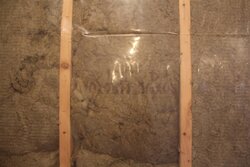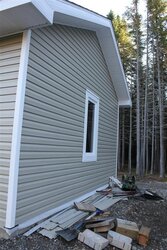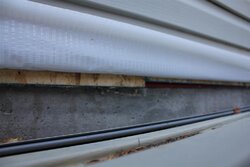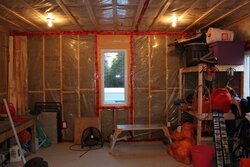Hey guys
2 years ago I built myself a garage with a friend. Everything went well. Then I noticed that at the back of my garage, condensation formed under my VB. It is the ONLY part of the garage that has this issue. So I just slit it open, let ie dry out. Then 2 weeks ago I taped it up (the slashes I had made) and within 24 hours, more condensation. SO, 3 days ago I tore the VB down and pulled the insulation (thinking there could be a water infiltration issue) and everything was bone dry.
So yesterday I put everything back, VB up, taped the seams, etc. Guess what?! This afternoon there is condensation again
So I am now thinking that perhaps some of the batts got wet during install (I remember it was raining outside and my buddy may have put some under a tarp...). Do these things dry?
Anyway, plan B is to go buy some cheap fiberglass insulation ($30 for 97 sq feet, Roxul is $51 for a bag of the comforttbatt ) and see what it does. But I gotta move everything in the garage, rip out the VB and insulation in the back wall...AGAIN. Sigh.
) and see what it does. But I gotta move everything in the garage, rip out the VB and insulation in the back wall...AGAIN. Sigh.
2 years ago I built myself a garage with a friend. Everything went well. Then I noticed that at the back of my garage, condensation formed under my VB. It is the ONLY part of the garage that has this issue. So I just slit it open, let ie dry out. Then 2 weeks ago I taped it up (the slashes I had made) and within 24 hours, more condensation. SO, 3 days ago I tore the VB down and pulled the insulation (thinking there could be a water infiltration issue) and everything was bone dry.
So yesterday I put everything back, VB up, taped the seams, etc. Guess what?! This afternoon there is condensation again
So I am now thinking that perhaps some of the batts got wet during install (I remember it was raining outside and my buddy may have put some under a tarp...). Do these things dry?
Anyway, plan B is to go buy some cheap fiberglass insulation ($30 for 97 sq feet, Roxul is $51 for a bag of the comforttbatt
 ) and see what it does. But I gotta move everything in the garage, rip out the VB and insulation in the back wall...AGAIN. Sigh.
) and see what it does. But I gotta move everything in the garage, rip out the VB and insulation in the back wall...AGAIN. Sigh.





 Oh and of course a beer fridge. Must not forget the beer.
Oh and of course a beer fridge. Must not forget the beer.
